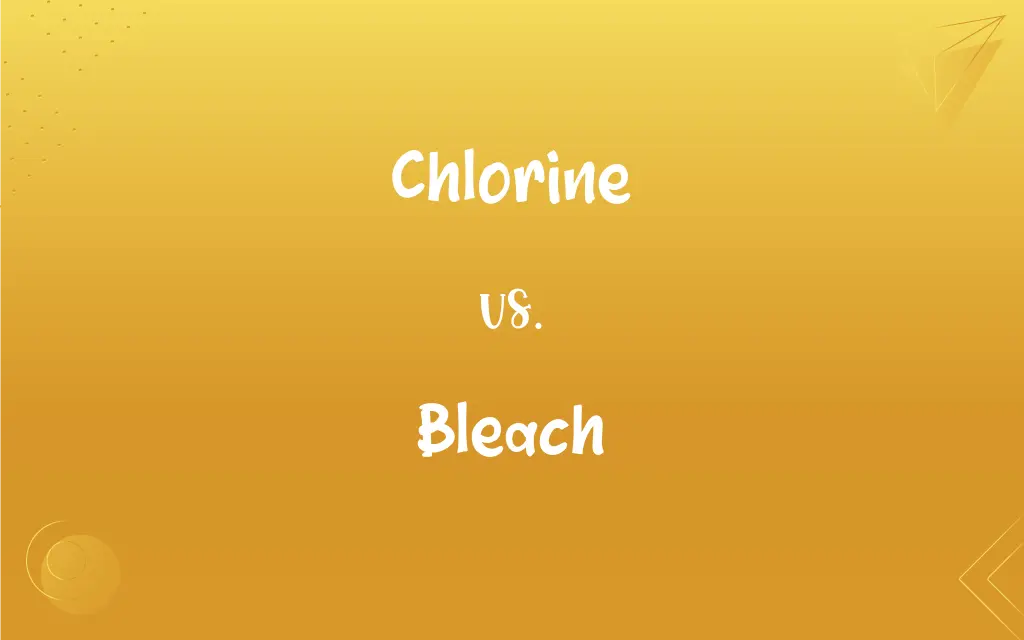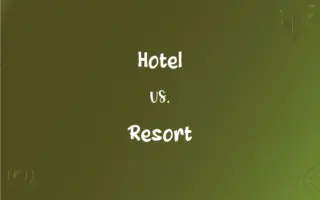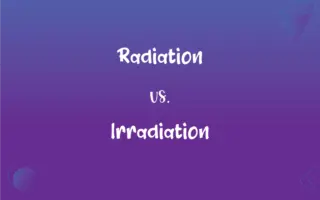Chlorine vs. Bleach: What's the Difference?
Edited by Janet White || By Harlon Moss || Updated on July 12, 2024
Chlorine is a chemical element, while bleach is a solution containing chlorine or other agents that whiten or disinfect.

Key Differences
Chlorine is a chemical element with the symbol Cl and atomic number 17. It is a yellow-green gas at room temperature and is known for its strong, pungent odor. Bleach, on the other hand, is a broad term for substances that lighten or whiten colors and includes substances that can disinfect.
Chlorine, as an element, is used in various applications, including water purification, disinfection, and in the production of various products like solvents and plastics. Bleach, when referred to in household terms, usually indicates a solution containing sodium hypochlorite, which releases chlorine when in water, giving it its disinfecting properties.
Chlorine is crucial in the chemical industry and is used in the production of a wide range of products. Bleach, especially the household variety, is primarily used for whitening clothes, disinfecting surfaces, and water treatment in smaller scales like swimming pools.
Both chlorine and bleach have their hazards. Pure chlorine gas can be very harmful if inhaled and can react with other substances to produce toxic compounds. Bleach, due to its chlorine content or other active ingredients, can be corrosive and can produce harmful fumes if mixed with other household chemicals.
In summary, while chlorine is a basic chemical element with diverse applications, bleach is a solution that often contains chlorine and is commonly used for disinfecting and whitening.
ADVERTISEMENT
Comparison Chart
Nature
Chemical element
Solution with whitening or disinfecting properties
Symbol/Formula
Cl
Varies (e.g., NaClO for household bleach)
Primary Use
Disinfection, production of chemicals
Whitening, disinfection
State at Room Temp
Yellow-green gas
Liquid (commonly)
Associated Hazards
Toxic if inhaled
Corrosive, can produce harmful fumes
ADVERTISEMENT
Chlorine and Bleach Definitions
Chlorine
Chlorine is crucial for water treatment processes to kill bacteria and other pathogens.
Municipalities add chlorine to tap water to ensure it's safe to drink.
Bleach
Bleach is a solution used to whiten or disinfect substances.
She used bleach to get the stain out of her white shirt.
Chlorine
Chlorine reacts readily with other elements to form compounds.
When chlorine reacts with sodium, it forms table salt.
Bleach
Bleach can be harmful if ingested or if it comes into contact with the skin in concentrated forms.
Always wear gloves when handling undiluted bleach.
Chlorine
Chlorine is a yellow-green chemical element with strong disinfecting properties.
The strong smell near the swimming pool is due to the chlorine used to keep the water clean.
Bleach
Bleach can release harmful fumes when mixed with other chemicals.
Mixing bleach with ammonia can produce toxic chloramine vapors.
Chlorine
Chlorine is used in the production of many industrial and consumer products.
PVC, a type of plastic, is made using chlorine.
Bleach
Bleach is commonly used in households to clean and disinfect surfaces.
Wiping down the countertops with bleach can kill germs.
Chlorine
Chlorine can be harmful in its pure gaseous form if inhaled.
Breathing in pure chlorine gas can lead to severe respiratory issues.
Bleach
Bleach can refer to various chemicals that have whitening properties.
Oxygen bleach is gentler on fabrics than chlorine bleach.
Chlorine
A highly irritating, greenish-yellow halogen element, existing as a diatomic gas, Cl2, and capable of combining with nearly all other elements, produced principally by electrolysis of sodium chloride and used widely to disinfect water, as a bleaching agent, and in the manufacture of many important compounds including chlorates, sodium hypochlorite, and chloroform. Atomic number 17; atomic weight 35.453; freezing point -100.5°C; boiling point -34.04°C; specific gravity 1.56 (-33.6°C); valence 1, 3, 5, 7. See Periodic Table.
Bleach
To remove the color from, as by means of chemical agents or sunlight
Over time, the exposure to sunlight bleached the rug in front of the window.
Bleach
To make white or colorless
Dawn bleached the mountains.
FAQs
Can bleach be used to disinfect drinking water?
Yes, but it should be used in the correct amounts and allowed to dissipate before drinking.
Can using bleach harm the environment?
Yes, excessive or incorrect disposal of bleach can harm aquatic life and the environment.
What is chlorine?
Chlorine is a yellow-green chemical element with disinfecting properties.
Can bleach be used for laundry?
Yes, bleach is commonly used to whiten and disinfect laundry.
Why does chlorine have a distinct smell?
The distinct smell is due to the presence of chloramine, formed when chlorine reacts with organic substances.
How should bleach be stored?
Bleach should be stored in a cool, dry place, away from direct sunlight and out of children's reach.
How is chlorine used in pools?
Chlorine is added to pools to kill bacteria and algae, ensuring the water is safe.
How does chlorine disinfect water?
Chlorine kills bacteria and other pathogens by breaking down their cell walls.
Can bleach be used on colored fabrics?
There are color-safe bleaches designed for colored fabrics, but regular bleach might fade them.
What is bleach?
Bleach is a solution, often containing chlorine, used to whiten or disinfect.
Is chlorine found in nature?
Yes, chlorine is found in natural salts and minerals, often combined with other elements.
Is it safe to mix bleach with other cleaners?
No, mixing bleach with certain chemicals can produce toxic fumes.
Can chlorine be harmful?
In its pure gaseous form, chlorine can be harmful if inhaled.
Can bleach harm fabrics?
Yes, overuse or incorrect use of bleach can weaken and discolor fabrics.
How is bleach produced?
Household bleach is commonly produced by introducing chlorine gas into a sodium hydroxide solution.
Does bleach have an expiration date?
Yes, bleach can degrade over time, reducing its effectiveness.
Is chlorine used in the production of medicines?
Yes, chlorine and its compounds play a role in the production of various pharmaceuticals.
Is chlorine used in the production of plastics?
Yes, chlorine is essential in making several types of plastics, including PVC.
Is chlorine present in our daily drinking water?
Yes, many municipalities add chlorine to tap water to disinfect it.
What's the difference between chlorine and chloramine?
Chlorine is an element, while chloramine is a compound formed when chlorine reacts with ammonia.
About Author
Written by
Harlon MossHarlon is a seasoned quality moderator and accomplished content writer for Difference Wiki. An alumnus of the prestigious University of California, he earned his degree in Computer Science. Leveraging his academic background, Harlon brings a meticulous and informed perspective to his work, ensuring content accuracy and excellence.
Edited by
Janet WhiteJanet White has been an esteemed writer and blogger for Difference Wiki. Holding a Master's degree in Science and Medical Journalism from the prestigious Boston University, she has consistently demonstrated her expertise and passion for her field. When she's not immersed in her work, Janet relishes her time exercising, delving into a good book, and cherishing moments with friends and family.































































